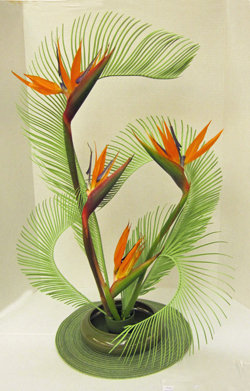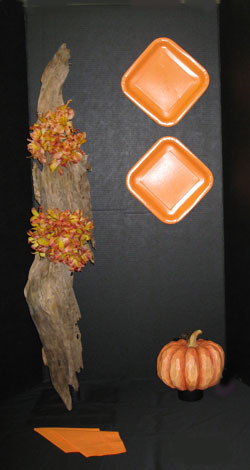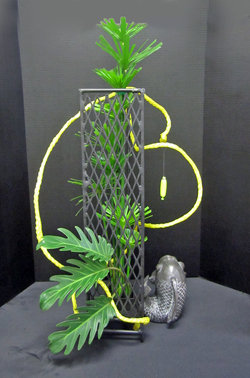National Garden Clubs is a ?go to? place for people wishing to learn about floral design. After a few short lessons, prospective designers learn that NGC designs are different from those they are accustomed to seeing in florists, grocery markets, and other places where floral designs are constructed or sold. NGC has spent many years preparing curriculum and organizing schools to teach the art of floral design.
First of all, NGC teaches floral design as an art. The definition, according to NGC is, “The art or organizing the
Elements of Design (line, form, color, texture, pattern, size, space, light) found in plant materials and other (optional) components according to the
Principles of Design (balance, contrast, dominance, proportion, scale, rhythm) in order to attain the
attributes of design.” Once this definition is introduced to students, a lifetime of studying, practicing, and judging can be spent in the quest of learning and perfecting the art.

The elements of design might be thought of as the ingredients. Suppose, for instance, one decides to bake a cake from scratch. Anyone can make a plain old cake out of a box, just as anyone can place a bouquet of flowers in a vase. This, however, is not the idea. Imagine a decorated cake; one for a special birthday or a wedding – perhaps one entered in a cake decorating competition.
First of all, the ingredients are assembled, such as flour, sugar, milk, butter, and chocolate. These are the elements (ingredients) used to make the cake. Then the ingredients are mixed and baked according to directions, cooled, assembled, and decorated.
Needless to say, the cake decorator will strive to have the most attractive cake possible. The cake, hopefully, is balanced and not leaning or sliding off the plate. It is in proportion to its plate, and ideally decorated with flowers or other ornamentation of the proper scale in colors that will contrast with the icing. Something is dominant because too much contrast leads to confusion, and if the decorator has done a good job, the viewer’s eye will be led smoothly through the whole to notice all parts of the finished work.

NGC floral designers approach a floral design in much the same way, which leads to the realization that all artistic endeavors share the same principles of design. The elements used to make various forms of art differ. The painter uses paint, an easel, a canvass, water or paint thinner, and other ingredients necessary to execute the idea envisioned. However, the painter is still concerned with the principles of art. The same ones apply to the painting, the cake, the floral design, and all other art forms. NGC floral designers attempt to bring about the attributes of design in their creations, which include beauty, harmony, distinction, and expression. While beauty and harmony probably are understood by all, distinction is a more elusive quality. To artists and floral designers, distinction is a desired quality resulting from superior selection and execution of all other considerations: conformance, design, artistic concept, expression, condition, and craftsmanship. Expression is that which communicates to the viewer an idea, emotion, mood, or story in an imaginative and unique manner (NGC definitions).

NGC has various study groups that meet for the purpose of learning and practicing floral design. The Florida Federation of Garden Clubs has a copyrighted program called Floral Design Studies. In this course of study, the student is led by qualified instructors from basic to advanced floral design in a series of nine units spread over time. Other states have similar programs, and NGC also has a course of study to teach floral design.
After taking the courses, the student is encouraged to enter Standard Flower Shows (flower shows sponsored by an NGC member club). This is where the fun and the real learning take place and where the excitement begins. Those who become enmeshed in this hobby are always challenged and excited when flower show time comes around. Exhibitors spend days planning their designs and entering them into competition.
Those of us who are bitten by the floral design bug always have something exciting to work towards. Floral design is a stimulating hobby that provides pleasure and fulfillment to its practitioners. It is a hobby that anyone can learn, and one that will provide a lifetime of enjoyment and gratification.
Reference:
Handbook for Flower Shows, Revised 2007, National Garden Clubs, Inc.
Credits:
Thumbnail by the author
Design using sago and Strelitzia by Carole Martin, Florida Federation of Garden Clubs Floral Design Studies instructor.
Design interpreting "Halloween" by Janice Hamlin, NGC Floral Design Instructor
Design interpreting "Fishing" by the author, FFGC FDS Instructor and NGC Horticulture Instructor






 The elements of design might be thought of as the ingredients. Suppose, for instance, one decides to bake a cake from scratch. Anyone can make a plain old cake out of a box, just as anyone can place a bouquet of flowers in a vase. This, however, is not the idea. Imagine a decorated cake; one for a special birthday or a wedding – perhaps one entered in a cake decorating competition.
The elements of design might be thought of as the ingredients. Suppose, for instance, one decides to bake a cake from scratch. Anyone can make a plain old cake out of a box, just as anyone can place a bouquet of flowers in a vase. This, however, is not the idea. Imagine a decorated cake; one for a special birthday or a wedding – perhaps one entered in a cake decorating competition. 
 NGC has various study groups that meet for the purpose of learning and practicing floral design. The Florida Federation of Garden Clubs has a copyrighted program called Floral Design Studies. In this course of study, the student is led by qualified instructors from basic to advanced floral design in a series of nine units spread over time. Other states have similar programs, and NGC also has a course of study to teach floral design.
NGC has various study groups that meet for the purpose of learning and practicing floral design. The Florida Federation of Garden Clubs has a copyrighted program called Floral Design Studies. In this course of study, the student is led by qualified instructors from basic to advanced floral design in a series of nine units spread over time. Other states have similar programs, and NGC also has a course of study to teach floral design.